
19 minute read
THOUSANDS OF AKRON’S
Child asthma impacts thousands of Akron kids
by Noor Hindi
Advertisement
Dwight Slater describes his 13-yearold son’s asthma attack as one of the most terrifying moments of his life. In the middle of the night, Dwight could hear Mikhail gasping for breath, later turning blue as Dwight rushed to dial 911. For about 30 seconds, Mikhail stopped breathing.
“It was the longest 30 seconds of my life,” Dwight says. “[Mikhail] was really scared.”
Mikhail spent three days in the hospital, and that wasn’t the first time his life was interrupted as a consequence of his severe asthma attacks. In November 2018, Mikhail had an asthma attack at school and spent the day in the hospital after being transported by an ambulance.
After this incident, Mikhail was placed on Akron Children’s Hospital asthma registry list, which includes 30,000 other children between the ages of 2 and 18 from Summit County and beyond. Of those 30,000 kids, about half are considered high risk, including Mikhail.
Above: Illustration by Chris Harvey. Not based on the likeness of the subjects in this story.
of America (AAFA) has named 20 U.S. cities “asthma capitals,” or particularly challenging places to live if you have asthma. Five Ohio cities are on the list: Akron, Dayton, Cleveland, Cincinnati and Columbus. Akron is ranked 14 out of 20.
On par with national averages, Black residents of Akron are twice as likely to die from asthma as white residents, and in Ohio, Black children are more likely to have asthma than white children. This is due to poor social determinants of health, like living next to a freeway or other pollution source, living in an older home, or not having health insurance.
Sam Rubens, Summit County Public Health’s manager of air quality and solid waste, says living next to a highway, which contributes to so much air pollution, is a big reason why Ohio’s numbers are so high.
Dr. Cooper White, director of the Locust Pediatric Care Group at Akron Children’s Hospital, says respiratory viruses like the flu during Ohio’s winters cause an asthma burden for many kids. “We always see huge bumps in our asthma frequency [during the winter],” he says. “There are socioeconomic factors, too. If you live in poverty and in inner-city areas, you’re much more likely to have asthma. These factors tend to be relevant in cities like ours.”
Rubens argues that the numbers in Ohio are especially high because our cities have “really good hospital systems,” making people more likely to utilize them, which drives up numbers simply because Ohio would have more data than states with inferior hospital systems.
Statistics from the AAFA support Rubens’ argument. All five Ohio cities on the list are ranked worse than average for ER visits for asthma but are average for the number of deaths and estimated asthma prevalence. No Ohio cities are ranked better than average in any marking.
ASTHMA CAUSES SCHOOL ABSENCES, LIMITED SOCIAL ACTIVITY
dying from asthma is rare. For example, according to the Centers for Disease Control and Prevention, in 2007, of the roughly 250,000 children with asthma in the U.S., 10 of them died.
This is not to underscore the severity of living with asthma.
“You can go weeks without eating. You can go days without drinking. But try and hold your breath for more than two minutes and it’s all over,” Rubens says.
Dr. White also says most kids have mild, intermittent asthma that requires occasional use of an inhaler. But for some kids, it can negatively affect their lives in big ways, causing an inability to interact with friends and attend school.
“For the ones that are more affected with persistent asthma that’s not well controlled, oftentimes they have a chronic cough. There’s always that feeling in your lungs that you’re not well,” Dr. White says. “And nighttime cough, in particular, is a problem because it interferes with sleep. The ability to participate fully in life can also be impaired. These are the kids
School absenteeism is a big issue for children with asthma. According to the CDC, low-income populations, minorities and children living in inner-city areas are more likely to be hospitalized due to asthma, interrupting their learning.
Additionally, a study published by the American Journal of Preventive Medicine finds that asthma is associated with more than 10 milled missed school days annually. The study links this data with “lower academic performance, especially among urban minority youth.”
Michele Wilmoth, director of nursing for the school health programs at Akron Children’s Hospital says during the 2018- 2019 school year, school nurses had to use their emergency stock inhalers 50 times. The numbers grew to 74 times during the 2019-2020 school year.
The emergency stock inhaler program was implemented in 2017. Before this, EMS would immediately be called, and the child having an asthma attack would be taken to an emergency department. These numbers are taken from the roughly 300 schools Akron Children’s Hospital works with in Akron and neighboring cities. partnered and launched the Managing Asthma Triggers at Home (MATH) program. The three institutions work together to identify high-risk asthma patients who they define as a child who has been hospitalized for asthma twice in one year, visited an emergency department three times a year, or intubated for asthma, among other criteria.
Once identified, the program does an assessment of an enrolled family’s house to locate asthma triggers, then provides the household with a vacuum cleaner, asthma-friendly bed and pillow bags, a dehumidifier and a HEPA unit, which purifies the air. Each quarter, they do an asthma control test at the house to test air quality and mold. They also provide education to the family to help manage asthma triggers at home. For example, they show the family how to change their furnace filter to prevent dirt and dust from building up.
“There are things that are evidence-based interventions, but if you’re just moving through life and all of a sudden your kid has this really bad, easily triggered asthma, that’s not the first thing on your mind,” Rubens says.
who tire easily on the soccer field. And they have to take breaks and recover to fully participate.”
Kent State University student Allison Erin Cooper grew up with severe asthma. While it was mostly exercise-induced, it was especially triggered in the winter months and hindered her ability to play sports.
“I played soccer but I was a goalie because I couldn’t run, so that kind of sucked. I played softball but that really doesn’t include a lot of running. I was mostly in the outfield,” she says. “I couldn’t keep up with my friends. I couldn’t run around with my cousins or else I’d start wheezing.”
For Allison, her asthma attacks were often coupled with anxiety attacks, worsening symptoms.
“It happens so fast,” she says. “Everything closes up and you’re just gasping. It kind of feels like you’re drowning. Your chest gets tight and it hurts, and you start crying and then you start freaking out.” The program has helped APS and Akron Children’s Hospital track high-risk asthma students, get them the help they need, and ensure the student stays in school.
“I always think of Maslow’s Hierarchy of Needs,” Wilmoth says. “If you’re hungry, if you need medical care, you can’t breathe adequately, you’re not going to be able to get your academic potential met.”
For each missed school day, parents are also impacted because they’re missing work to care for the child. The program is free and has a total of 80 families enrolled. It lasts for one year, and Dr. White says the program is saving the city money by reducing hospital utilization.
Many of the families in the program are housed through AMHA’s voucher program. AMHA director Brian Gage says they specifically chose families in the voucher program because AMHA houses already have a preventative maintenance program. They’re smoke-free, they regularly change air filters and they’ve removed carpeting.
“If you can’t breathe, you can’t learn. You can’t learn to your fullest potential. And if your child has asthma, they’re not going to school, they’re going to the hospital. You’re not going to work, you’re going to the hospital,” Rubens says.
ASTHMA TRIGGERS LURK IN AKRON HOMES
Though doctors can prescribe medicine and reduce the risk of asthma, if at-home triggers aren’t removed, a child’s life can continue to be interrupted. These triggers can include smoking, pets, dust trapped in carpet, and mold. Since being part of the program, Mikhail’s asthma has improved. In the past, Dwight says Mikhail’s asthma was a source of anxiety and fear. Mikhail was also missing about a week of school each year due to his asthma. Today, he doesn’t miss any school.
“He’s pretty much equipped with everything he needs to keep dust and pollen outside the home,” Dwight, his father, says. “He’s an honor roll, merit roll student. He doesn’t think about his asthma too much anymore.”
// Noor Hindi is The Devil Strip’s Senior Reporter. Email her at noor@thedevilstrip. com.
Thedevilstrip.com/co-op
Artwork at right: Two scenes designed from items that Akron Public Schools kindergarten and first-grade students found near their homes. Used with permission from art teacher Pam McElhaney.
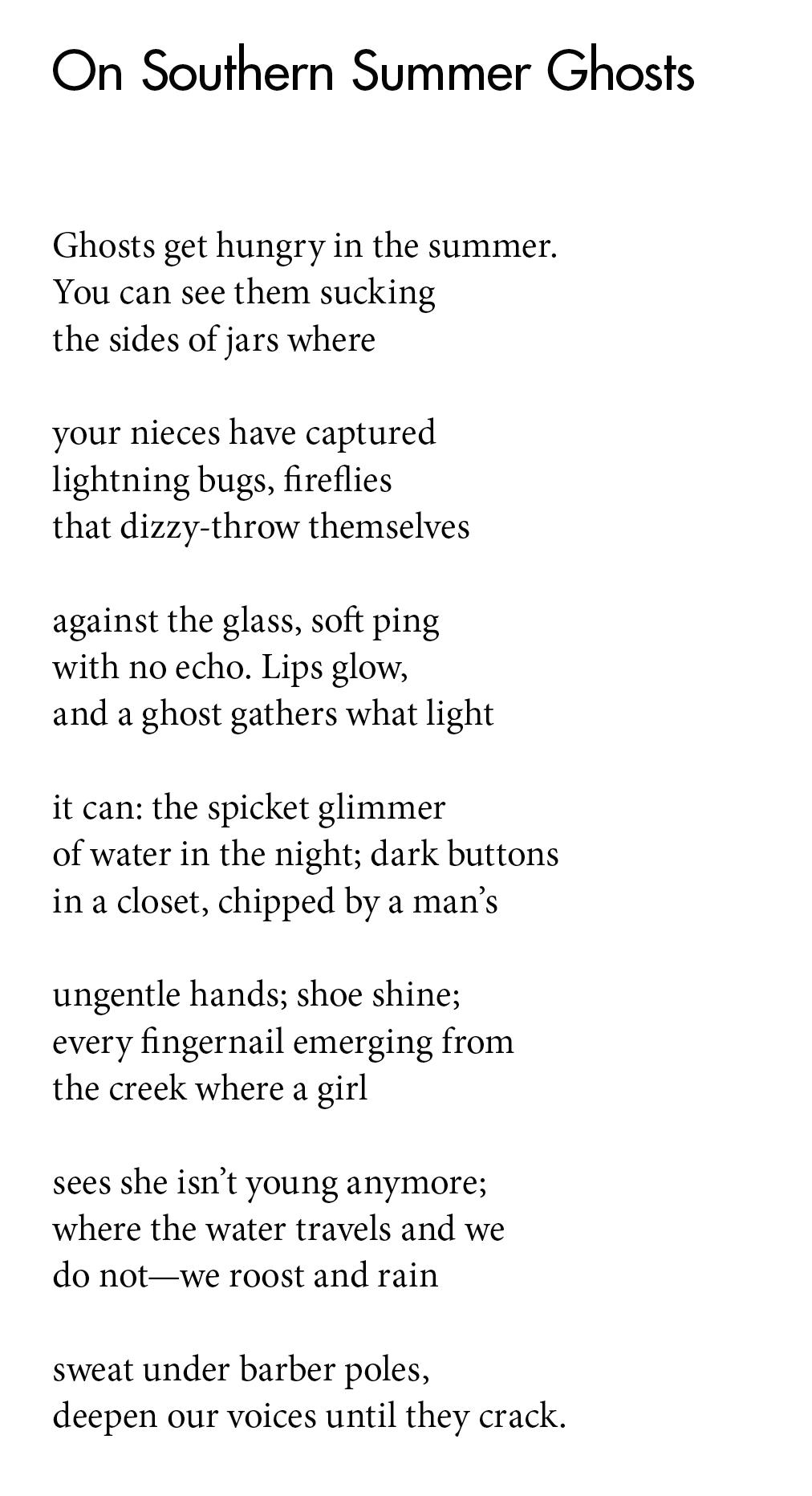
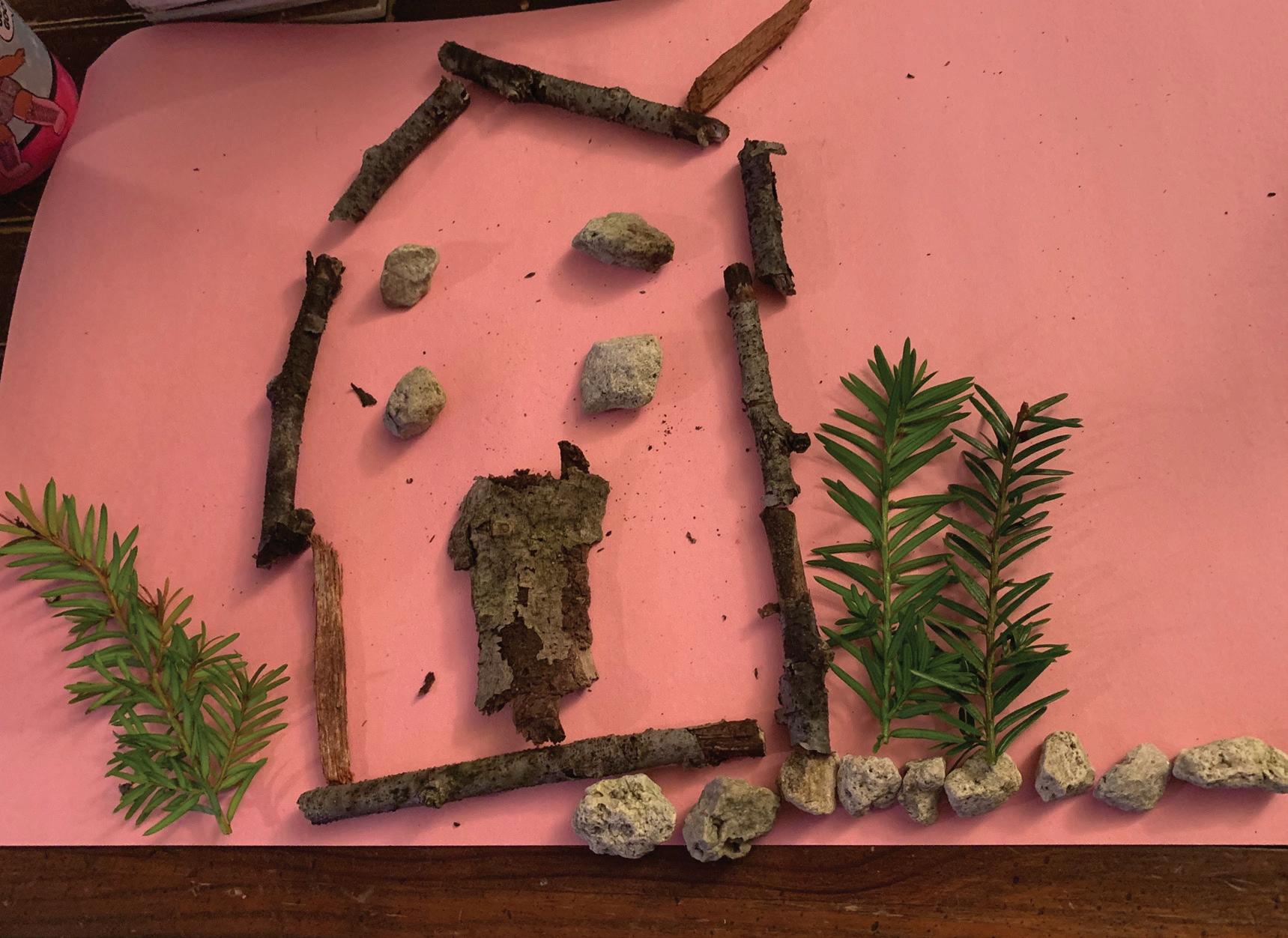

Above poem, published by the University of Akron Press: “On Southern Summer Ghosts” appears in Witch Doctrine by Annah Browning. Browning is the author of a chapbook, The Marriage (Horse Less Press, 2013) and poetry editor and cofounder of Grimoire Magazine. Her poetry has appeared in Indiana Review, Black Warrior Review, Willow Springs, Boulevard, and elsewhere. She earned her MFA from Washington University in St. Louis and her Ph.D. from the University of Illinois at Chicago.
Right poem, published by the University of Akron Press: “from Lost Song” appears in Quite Apart by Krystal Languell. Languell lives in Chicago, where she works for the Poetry Foundation. Her previous books are Call the Catastrophists (BlazeVox, 2011) and Gray Market (1913 Press, 2016). She has also published six chapbooks, including Be a Dead Girl (Argos Books, 2014) and Archive Theft, a collection of interviews, (Essay Press, 2015).

In 2008, Teresa Mazey was driving a truck. Now, 12 years later, she’s operating her own business with three locations. Teresa is the founder of Empty Bin Zero Waste, a company that makes and sells reusable housewares meant to replace single-use products.
Empty Bin Zero Waste is more than a retail outlet. It’s a way of life Teresa is trying to pass along.
“I’m really trying to get people to start homesteading, start getting away from the need for large corporations. We can do everything they can do better, cheaper and cleaner,” Teresa says.
Beeswax wraps replace shrink wrap. Hand-sewn sandwich bags replace their plastic counterparts. Teresa even sells her own blend of laundry detergent.
To facilitate people’s interest in getting out from under the thumb of large companies and corporations that pollute, Teresa sells a DIY recipe book with instructions on how to make common household items like shaving cream or oven cleaner.
“At our store in Canton, we have a bunch of bulk items,” she says. “People can get all the ingredients they need to make their own lip balm, or make their own shampoo.”
For those disinclined to take the time to make these things themselves, there are scores of already-made items for sale at the Empty Bin Zero Waste flagship store in Canton, as well as a storefront at Northside Marketplace in Akron and Alley Cats Marketplace in New Philadelphia. Shampoo bars, lip balm and wax wraps can all be had for reasonable prices, and they’re made using ecologically friendly and sustainable methods. The only location carrying bulk items is the store in Canton because of space constraints at the two other stores.
Teresa’s commitment to the Empty Bin Zero Waste ethos means that one of her biggest struggles is finding other zero-waste companies to work with that adhere to the guidelines she’s set for her own business. According to Teresa it’s almost impossible to find companies that source the materials she needs that aren’t packaged in ways that are harmful to the environment.
“If you order stuff from another zerowaste store, why do they send it to you in a [plastic] bag?” Teresa asks. Even biodegradable packing peanuts are anathema to her mission because, while they might be biodegradable, they aren’t backyard compostable — thus creating more waste.
“I don’t know if I’m, like, over-thetop, but it’s what I believe in and I want complete transparency with my customers,” she says.
Overcoming that dichotomy can be frustrating, but Empty Bin Zero Waste’s customers keep Teresa dedicated to her goal. The reaction to her business is the antithesis of negativity. “I’ve had people come in and cry because they were so happy that somebody opened something [like this],” Teresa says.
Aside from being a retail outlet, Empty Bin Zero Waste’s physical stores act as incubators for conversations about living an eco-friendly lifestyle. “I get families in there, right, and one will be laughing about something like, ‘That’s absolutely ridiculous,’ and then the kid will be like ‘No, it has to happen because of this, this, and this,” Teresa says. “They’ll have a whole discussion.”
Starting down the path of a zero-waste lifestyle seems daunting, but there are a few relatively small steps people can take in the beginning that will make a world of difference.
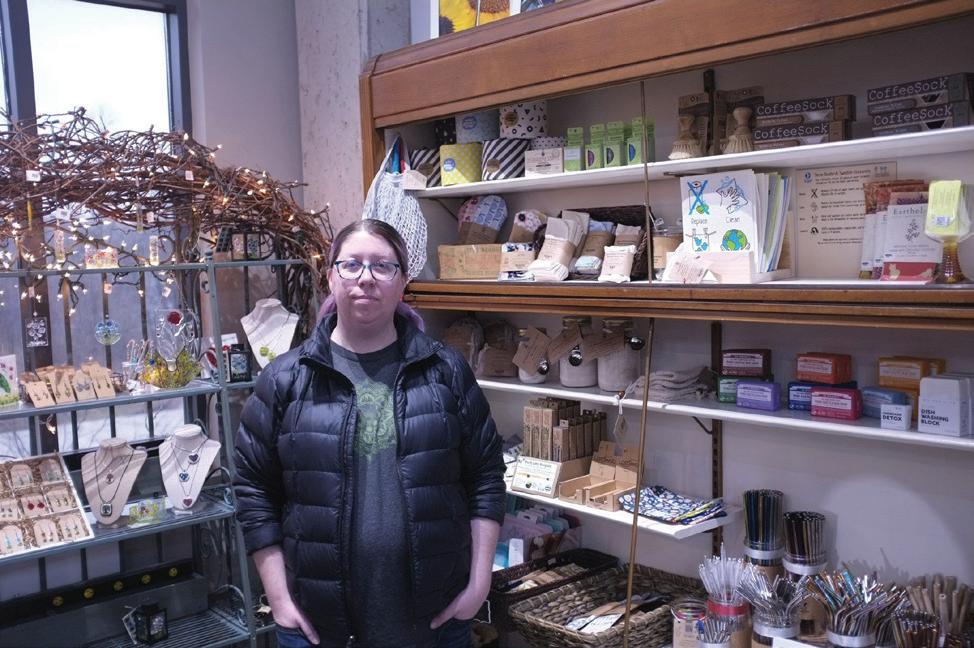
“I always tell people to start with bags, ‘cause that’s the easiest thing,” Teresa says. “Start always remembering your bag when you go grocery shopping, and if you forget it, just don’t use a bag. When it’s 30 degrees and you gotta load everything individually into your car, you’ll start remembering.
“The second best [thing to do] is bringing a drink with you in a reusable cup so that you’re not using a disposable cup,” Teresa says.
But the key to sustaining the lifestyle is easing into it. “Master one thing, get comfortable with it, and then move on,” Teresa says.
Perhaps surprisingly, Teresa advocates for improvising before buying. “Always use what you have at home before you buy anything. I’m a retail company, straight up just selling that. You do not need to buy what I have, you can make it,” she says. “You can cut up a T-shirt and that gives you hankies, that gives you paper towels.” If you get creative, you’d be surprised what you don’t need to buy.
Certainly there’s the larger ecological impact to consider, but there’s also the economic impact on the individual. The laundry detergent that Teresa has been making for five years cost roughly $3 for about 50 loads.
As with so many small businesses, Empty Bin Zero Waste’s operations have been halted by the COVID-19 pandemic. On March 26, Empty Bin Zero Waste told its Instagram followers that the business is closed and not currently fulfilling online orders. The post encourages users to still leave reviews or start a wish list on their website. Those interested in supporting the store while it’s shut down are encouraged to purchase an e-gift card for use when the store reopens. Unfortunately, there is a note on their website stating that their Northside Marketplace location will be closing permanently in September.
With business temporarily suspended, Teresa is working on making a back stock of items that she sews (handkerchiefs, for example), making some new items and organizing business files. She’s also been doing her part to help out during the emergency.
“I donated a bunch of fabric, elastic and wire to others that are making face masks,” she says.
That she would donate her supplies to those working to keep others safe is no surprise. Empty Bin Zero Waste’s dedication to doing good is best summed up by the founder herself:
“I’m just doing what I’m passionate about and trying to make a difference,” Teresa says. “If that means that someone uses a [reusable] bag instead of a plastic bag, then it’s a win.”
Learn more about the company’s products at emptybinzerowaste.com.
// Derek Kreider is a writer and sometimes musician, as well as The Devil Strip’s distribution manager. Reach him at derek@thedevilstrip.com.
GET LIT WITH

Akron’s only custom lighting shop
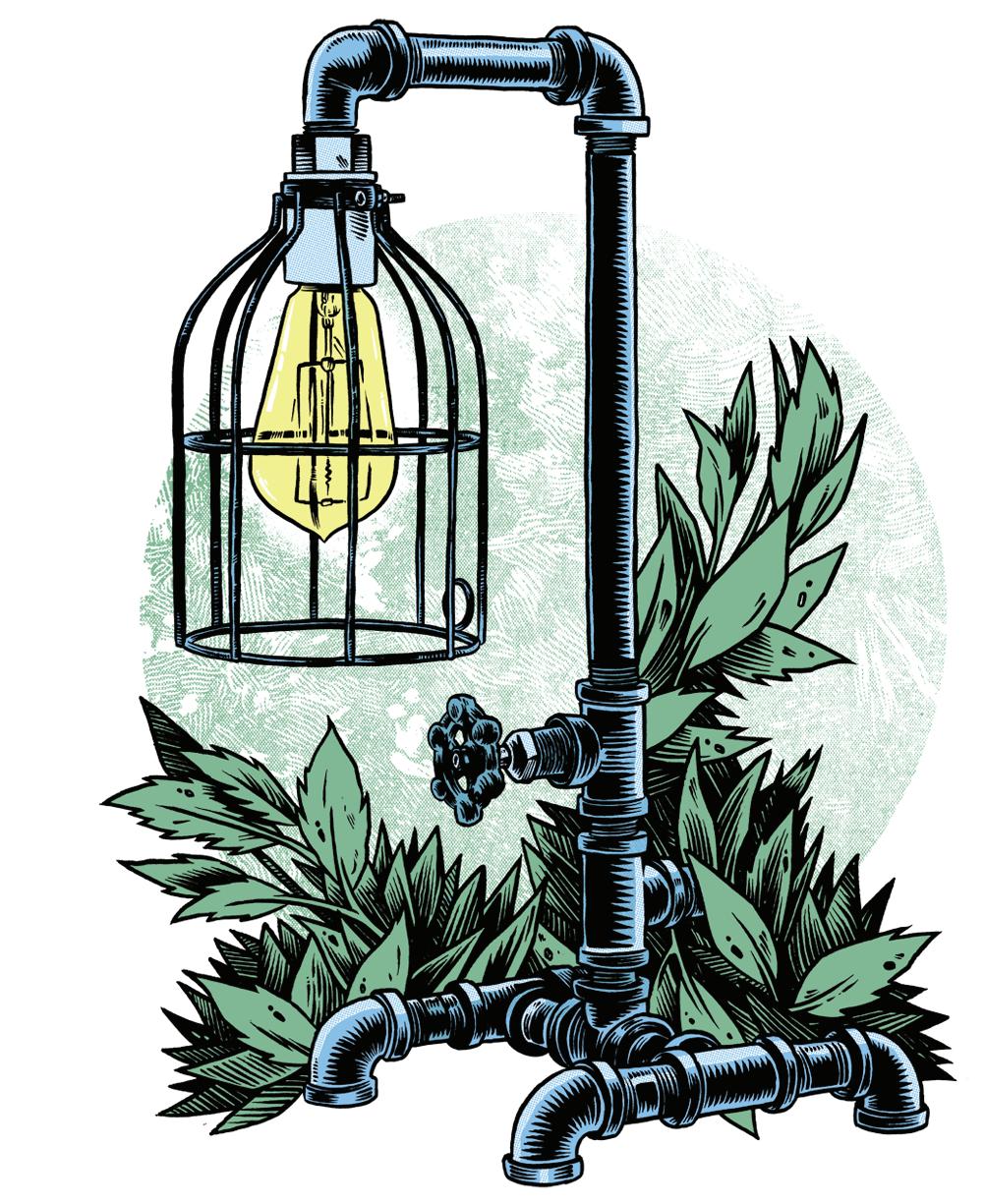
Showroom Open: Saturday 11-4 or by appointment. Saalfield building 1145 Getz Akron oh 44301. st#306 3rd floor www.whiskertin.com
THE EYE OPENER IS OPEN FOR TAKEOUT MONDAY - SATURDAY 6:30 AM - 2 PM | SUNDAY 8 AM-2 PM
Graphic novel depicts lives of four Kent State students killed during protests in 1970
by Lauren Dangel
We have heard the names, read the newspaper clippings and listened to that Crosby, Stills, Nash & Young guitar riff. Many Northeast Ohioans have even seen the bullet holes in campus sculptures up close. However, the complexity of the lives underneath the surface of a 50-year-old narrative has been far less visible.
On May 4, 1970, Ohio National Guard troops opened fire on a crowd of unarmed students at Kent State University during a protest of the American invasion of Cambodia. They killed four students in the process.
Acclaimed graphic novelist Derf Backderf puts the focus on the four lives cut short in the first graphic narrative depiction of this tragedy, “Kent State: Four Dead in Ohio.”
The book comes out Sept. 7, its release delayed by the COVID-19 pandemic.
I spoke with Backderf about his research process and his goal in telling this story. Backderf first learned of the shooting as a 10-year-old Akron Beacon Journal paperboy, and the story has resonated with him ever since.
He follows each of the four students, switching between their perspectives, from May 1 to 4, depicting their frustrations and hopes, and he puts a human background to the well-known list of casualties. Backderf begins his graphic novel with his own eyewitness account of Ohio National Guard presence in his hometown of Richfield. He then follows these same guardsmen along with the four students over the course of the first four days of May 1970. However, Backderf puts the lives of William Schroeder, Allison Krause, Sandra Scheuer and Jeffrey Miller at the center. The reader gets a sense of each student’s personality, goals, fears, and especially, their sentiment toward the National Guard’s presence in Kent.
Periodically, Backderf provides context for certain groups, events, individuals and other factors that impacted Kent State’s political climate and the May 4 shooting. For example, he addresses the evolution of influence of Students for a Democratic Society (SDS) on antiwar sentiment on college campuses, the mindsets and decisions of state government leaders, and the planting of FBI informants on Kent State’s campus.
Significantly, he does not hesitate to call out intentional misinformation from those in power. When Backderf acknowledges legitimate uncertainty and calls attention to lies from authority figures, he provides an exceptionally effective lens through which to remember these events and learn more about them. He highlights the differences among 20-somethings of the time, rather than portraying college students as united for one cause.
The book provides an impactful display of a miscarriage of justice, and Backderf holds nothing back in depicting the friction between guardsmen and students and the brutality of the violence.
What meant most to Backderf as he learned about the four students’ lives, he says, was “just what remarkable kids they were. I mean, all four of them were just these amazing people who would’ve gone on to do, I think, pretty significant things. And that’s the real tragedy of the story — is what we lost, as a society. There are so many assholes in the world; we can’t afford to lose the good ones, and we lost four good ones.”
Backderf committed to an extensive research process to tell this story faithfully. He gained perspectives from all angles of the story, on both sides of the rifles and beneath the surface of the narrative that has been visible for 50 years. Backderf interviewed witnesses to the shootings and people who knew the four who were killed. He also consulted Kent State University archives during his research process. Backderf explained he found the account of an unnamed guardsman particularly surprising. “The guardsman account was surprising in its bluntness,” Backderf says. “I mean, he describes these acts of brutality that [are] hard to justify in any way. I mean, bayoneting some 20-year-old girl in the back, that’s pretty hard to come up with an excuse for” — and yet, he says the guardsman revealed this with surprising confidence.
In 2020, youth activism is still visible. Media consumers hear from environmental activists such as Greta Thunberg and voices of support for gun control such as the Parkland shooting survivors. However, the critics of these and similar figures, some old enough to be their parents or grandparents are about as visible. I asked Backderf what the youth of today can learn from the story of May 4, and what their skeptics can learn from it, too.
“It’s my belief that we’ve kind of circled right back around to 1970, in terms of rancor, in terms of divisive politics, in terms of ‘us versus them,’ and it seems like we’ve learned absolutely nothing on that journey,” Backderf says. “It’s my fear that we’re very close to another May 4. All that’s lacking right now in this country is people taking to the streets… Now the fight is all taking place online.”
He adds, “The big lesson of May 4 is that when you threaten, truly threaten, the people in power, the price of dissent can be bitterly high.”
As for the criticism of youth activism, Backderf says, “I don’t know that skeptics ever learn anything. That formula seems to be the same.”
A half century on from tragedy, Taylor Hall now houses Kent State’s School of Communication Studies, of which I am a proud alumna. The power and presence of the events of May 4 were undeniable during each walk to class during my time at the university. The thought that these were students looking ahead from their 20s with a mix of hope and fear, just like me, was especially impactful when I would walk to my favorite class of my time at Kent State: Freedom of Speech in the United States.
Backderf captures this punch to the gut in a faithful and blunt depiction. He pays tribute to distinct lives full of passion, hope and fear, not just a list of four victims.
the Akron-Summit County Public Library. The book is also available for purchase via publisher Abrams Books and on Amazon.

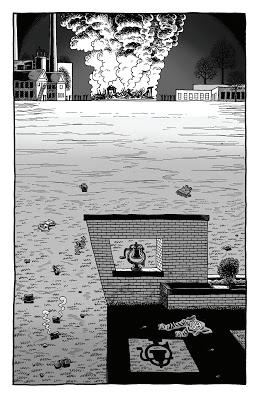
// Lauren Dangel is a digital content writer and proud Kent State University graduate. She is also a football and hockey contributor for SB Nation’s Notre Dame Fighting Irish blog, One Foot Down.









